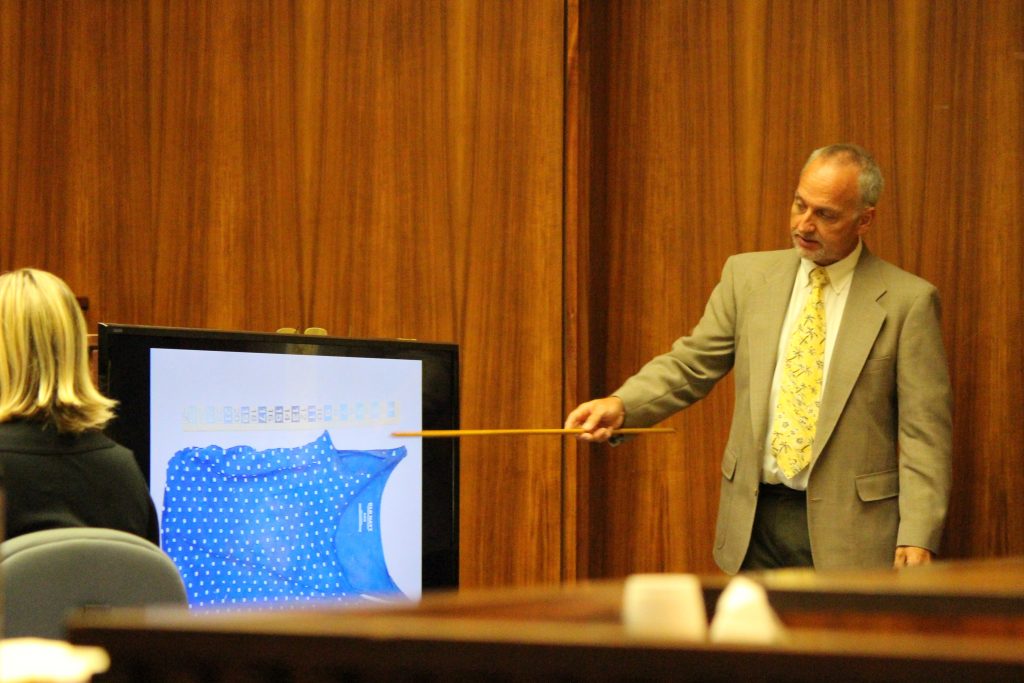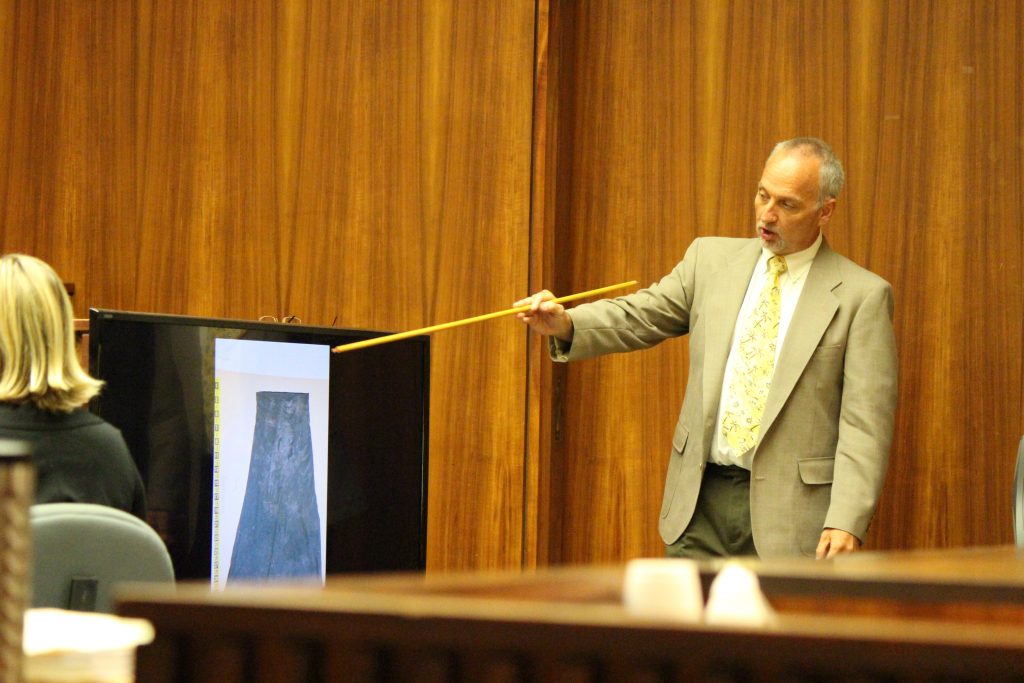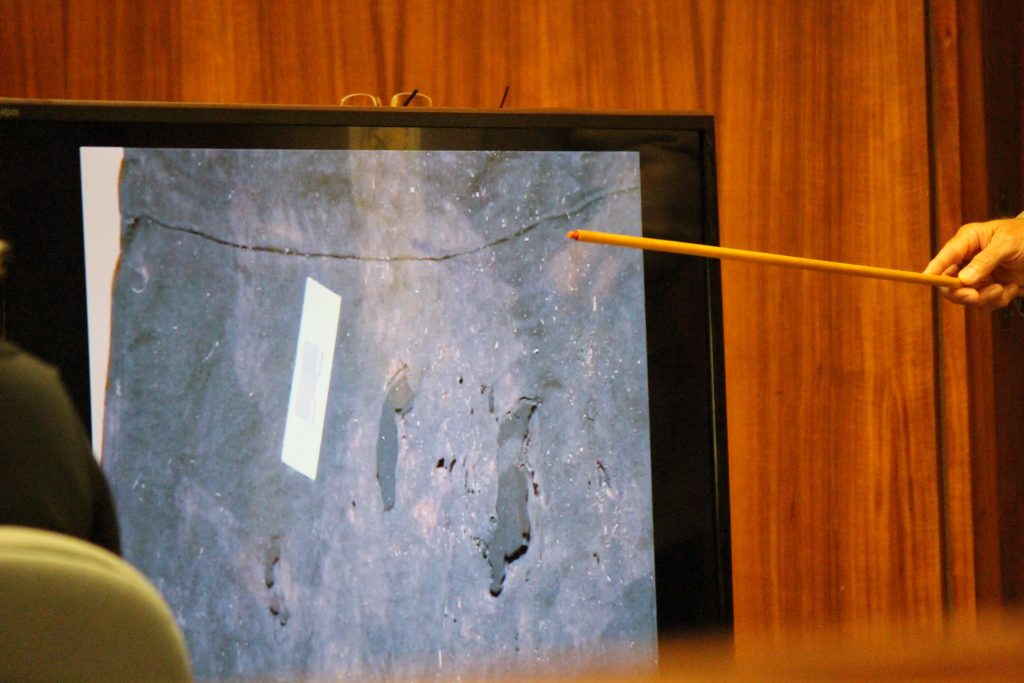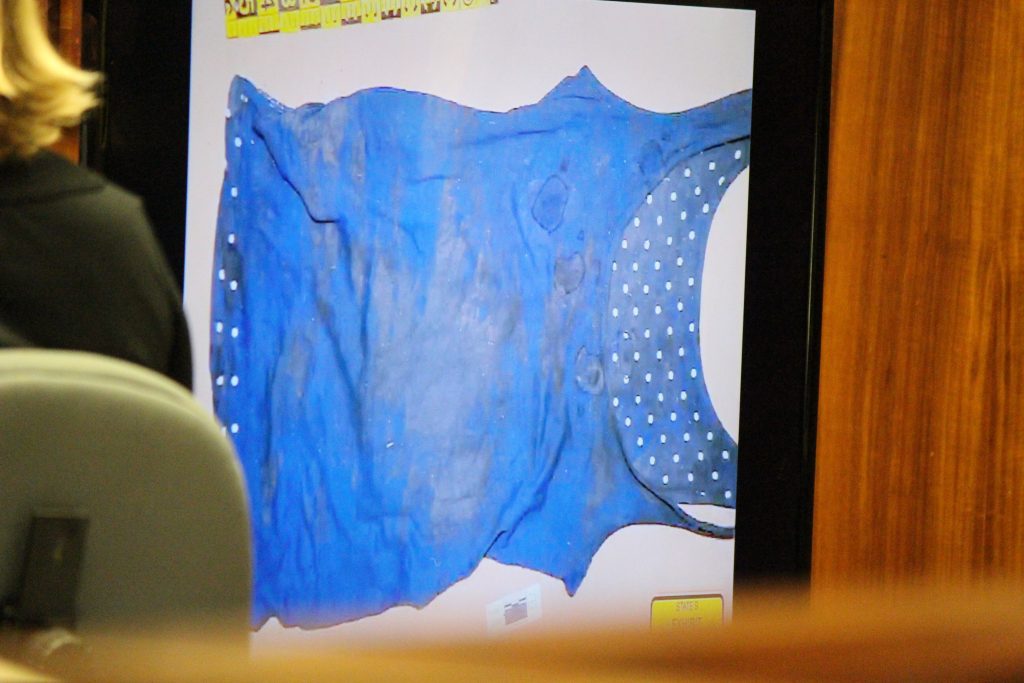Capobianco Trial: Numerous Holes, Reddish Stains on Clothing
By Wendy Osher
An evidence specialist with the Maui Police Department testified again this week in the ongoing murder trial of Steven Capobianco, describing how items recovered from Nuaʻailua Bay in East Maui were handled and the chain of command that police used in an effort to prevent contamination of evidence.
Capobianco is standing trial for the murder of his pregnant ex-girlfriend, Carly “Charli” Scott who was 27-years-old and five months pregnant with an unborn child fathered by the defendant when she went missing in February of 2014. Capobianco has pleaded not guilty to the charges.
Maui Police Evidence Specialist Anthony Earls said he conducted presumptive testing on various pieces of clothing including stains on a green blanket, long black skirt, blue tank top with polka dots, gray hooded jacket and black jeans to determine if the items should be forwarded for further testing to a DNA laboratory.
Earls also described how he packaged and shipped two fragments of the lower jawbone with teeth, two additional teeth, as well as three other bone fragments to the Central Identification Laboratory at the Joint POW/MIA Accounting Command located at Hickam Air Force Base on Oʻahu for forensic anthropological analysis. According to Earls, the items were packaged on March 22 and received by the JPAC facility on March 25, 2014.
Evidence Arrives at Wailuku Forensic Facility:
Early in the morning at around 2 a.m. on Friday, Feb. 14, 2014, Earls said he was contacted by his Lieutenant and was assigned to receive evidence from officer Christina Bonacorsi at the Wailuku Forensic Facility.
Earls said he accepted items that were wet and needed proper drying before packaging. Some items that were already in bags were placed in the facility’s secured refrigerator until he had the opportunity to process them, said Earls.
According to his testimony, Earls took inventory of the items the following evening on Saturday, Feb. 15, 2014. The process, he said, involved the removal and recovery of insect larvae that were placed in individual containers and labeled, while the items themselves were placed in forensic drying cabinets.
In addition to the clothing, Earls said, he also received two containers of maggots that were previously collected by officer Bonacorsi as well as two rolls of masking tape that were also found at the scene.
Clothing Had “Reddish Stains,” “Numerous Holes”:
As each item was entered into evidence, Earls described his observations saying, the black skirt that family members said belonged to Scott had “reddish stains on it–mainly on one side. In other words, there’s an exterior surface and an interior surface, using the seem as depicting which would be the interior. So, I noticed stains on the exterior surface of that black skirt.”
“The material of the skirt had numerous holes in one region of the skirt,” said Earls saying the stains were on the same side as the holes.”
Earls also described stains found on the blue tank top that family members said belonged to Scott. “It was a visible stain, an obvious stain. It was on predominantly one side, but there was some on the other side as well,” said Earls.
Earls said he took swabs and conducted presumptive testing on both items before packaging them back up. sealing the packages with evidence tape, and submitting the items as evidence to the department’s evidence custodian.
When an item is submitted into evidence, Earls described the process saying, “Each item is entered into the computer and then I print a voucher or an evidence and property report that describes what the item is, when it was collected, (and) who collected it,” he said. “But then it also has a chain of custody that will then show that I am the one that is submitting that evidence into storage, and then every time it is taken out of storage, again, whoever has to handle it, has to sign the chain of custody.”
Green Blanket Too Big to Place in Evidence Locker:
During testimony last week, Earls said he circled areas where presumptive testing was done on a green blanket. When the item was found by a stream at Nuaʻailua, it was covered in maggots and was wet from being partially submerged in the water, according to earlier testimony. Scott’s’ sister, Phaedra Wais also recognized the blanket, and said it belonged to Charli.
After the item was dried and photographed, Earls said he removed any trace evidence, including hairs or fibers. He then did a hand-to-hand transfer of the item to evidence custodians at the Wailuku Police Station, instead of placing the blanket in an evidence locker, because it was too big.
Forensic Light Source Used on Gray Hooded Sweatshirt,
50 Hairs Found, Some from a Dog
Earls said he used a forensic light source as well as tape lifting and presumptive testing on a gray hoodie recovered by a civilian search crew from along the stream at Nuaʻailua.
According to testimony, Earls said he used forceps to recover about 50 hairs from both the interior and exterior of the gray hooded jacket/sweatshirt. “And then there was actually more that were on the actual tape lifts,” said Earls. “Some of them appeared to me what I would consider dog hairs.”
“We used forceps or tweezers, but they’re sterile, they’re clean (and) unused. I placed any hairs and fibers into a little, small envelope and then used a method called tape lifting. It’s similar to a lint brush which you would use to clean off your clothes–the lint or hairs–and you use it to roll over the items,” said Earls.
“In this case, the jacket or the hooded sweatshirt was also rolled over. Those pieces of tape are placed onto a piece of mylar–or like the overhead transparencies that you used to use in school–(and) placed onto that sticky side down,” noting that’s the way he collected trace evidence from the exterior surfaces of various items.
“You want to check every surface, so you would do the front of the jacket exterior, flip it over, take the photographs, then you would do the exterior rear. Then you would take the jacket, turn it inside out. You would do the same thing. Repeat. Interior front, interior back. And then you would label each one of those tapes separately,” he said.
Prosecuting attorney Robert Rivera asked Earls to describe how he could tell the difference between dog and human hair and Earls responded saying, “Most people can recognize a dog’s hair or cat’s hair versus a human hair.” In explaining the difference he said, “Just the appearance. If it’s a long haired cat, it’s going to have longer hair. If it’s a short haired dog, like everyone has seen, it gets all over your clothing–the hair. So it’s going to be short and bristly,” he said noting that the appearance also differs depending from where on the body it comes.
“Visually, it would have to be completely different from the person’s human hair that we’re comparing to, for example, but you would need to look at it under a microscope to actually see if there’s certain characteristics that characterize it with animal hair versus human hair,” said Earls.
Earls said some of the areas that were stained, “especially on the sleeves” of the hoodie were swabbed with cotton and presumptive testing was conducted.
“I then actually used a forensic light source to visualize to look for any other stains that may not be visible with the white light,” said Earls.
Police Attempt to Lift Fingerprints from 2 Rolls of Tape:
Earls said the two rolls of tape that he received were air dried and police attempted to recover finger prints from them. The items were also dried, photographed and placed in a paper bag, sealed and submitted into evidence at the Wailuku Police Station.
Chain of Custody: Items Submitted into Evidence
The hoodie, like the other items was then submitted as evidence, and wrapped in paper to keep everything together. “Once it’s been totally documented, all of the trace evidence has been potentially removed, then the item, it’s now dry, is folded up nicely within the paper, and then placed into a container and then sealed by me and submitted for evidence in storage.”
Earls said evidence is typically placed in a box, envelope or bag, depending on the size of the item. “I securely transport the item. Once I have secured it within its packaging, and sealed it with the evidence tape, I then transport that securely to the Wailuku Police Station where it is then placed into a locked cabinet or locker. Then the key is dropped into evidence, so that the evidence custodian will then retrieve it later on, and then do their processing of it as well,” said Earls
“Once I drop that key, I can’t retrieve that key back,” he said.
Forensic Entomology Analysis Conducted on Maggots:
According to Earls, he received two urine specimen containers with maggots/insect larvae inside via hand delivery from Officer Bonacorsi at around 2 a.m. on Feb. 14, 2014.
Bonacorsi had testified that she recovered maggots from wet clothing that she received from search party members.
Another container held maggots collected from the ground at the Nuaʻailua crime scene near where a bra and clumps of hair had been recovered. Earls said the maggots collected were “actively moving” on the soil in what appeared to be a dried up stream bed.
On Saturday Feb. 15, 2014, he recovered the containers from out of a secured refrigerator and then proceeded to collect more maggots from the clothing and other items that were turned over to police.
Earls said he labeled each container so he would know which they came from, saying maggots were also removed from the gray hoodie, the green blanket, black jeans, black skirt, and from underneath a fingernail, and placed in separate containers.
On Feb. 17, 2014, Earls said he added some preservative to both of the containers he had received and sealed them back up.
The containers were submitted as evidence at the Wailuku Police Station and then signed out on May 22, 2014, so that they could be prepared for further analysis.
On May 23, 2014, Earls said he had used the preservative 10% formalin which the department has in the morgue, and noted that it is used “quite frequently.” But upon speaking with Dr. Lee Goff, Earls said it was recommended that he change the preservative from formalin to isopropyl (rubbing) alcohol, “which would help maintain the integrity of the evidence longer,” said Earls. He noted that he made the change before shipping the specimens out that day.
The maggots were packaged and dropped off at the Fed Ex office in the afternoon of Friday May 23, 2014, and were received in Honolulu on May 27, 2014, where Dr. Goff conducted forensic entomology analysis on the specimens. Earls described the analysis focus saying it was the study of insects and applying the findings to the law.
According to Earls, he received the specimens back on June 17, 2014.
Defense Attorney Jon Apo, questioned Earls about the chain of custody involving the maggots, and Earls agreed that documentation relating to the delivery of the maggots was not present on the specimens presented in court. “While one would expect to see his signature,” Earls agreed that it was not attached to those pieces of evidence.
Prosecuting attorney Robert Rivera suggested that the missing signatures may be attached to other evidence that was not currently under review.
Case History/Background:
Steven Capobianco is standing trial for the murder of his pregnant ex-girlfriend, Carly “Charli” Scott. He is also accused of setting her vehicle on fire.
Scott was 27-years-old and five months pregnant at the time with an unborn child fathered by the defendant. Capobianco has pleaded not guilty to the charges.
In the days following Charli Scott’s disappearance, Capobianco had done an interview with police in which he said Scott had picked him up on the night of Sunday, Feb. 9, 2014, and dropped him off at his truck that got stuck in Keʻanae on Feb. 8, 2014.
According to the account, both headed back to Haʻikū, with Scott following Capobianco in case his vehicle broke down again. Scott was reported missing the next night on Feb. 10, 2014, after she failed to show up for work and did not return phone calls and messages from her family members.
The trial is set to resume on Wednesday, Sept. 21, 2016.

Anthony Earls, evidence specialist with the Maui Police Department describes staining on a blue tank top found at Nuaʻailua Bay. Photo by Wendy Osher.

Anthony Earls, evidence specialist with the Maui Police Department. Photo by Wendy Osher.

Anthony Earls, evidence specialist with the Maui Police Department describes holes and staining observed on a black skirt recovered from Nuaʻailua Bay. Photo by Wendy Osher.

Anthony Earls, evidence specialist with the Maui Police Department describes holes and staining observed on a black skirt recovered from Nuaʻailua Bay. Photo by Wendy Osher.

Anthony Earls, evidence specialist with the Maui Police Department describes staining on a blue tank top found at Nuaʻailua Bay. Photo by Wendy Osher.

Anthony Earls, evidence specialist with the Maui Police Department. Photo by Wendy Osher.












